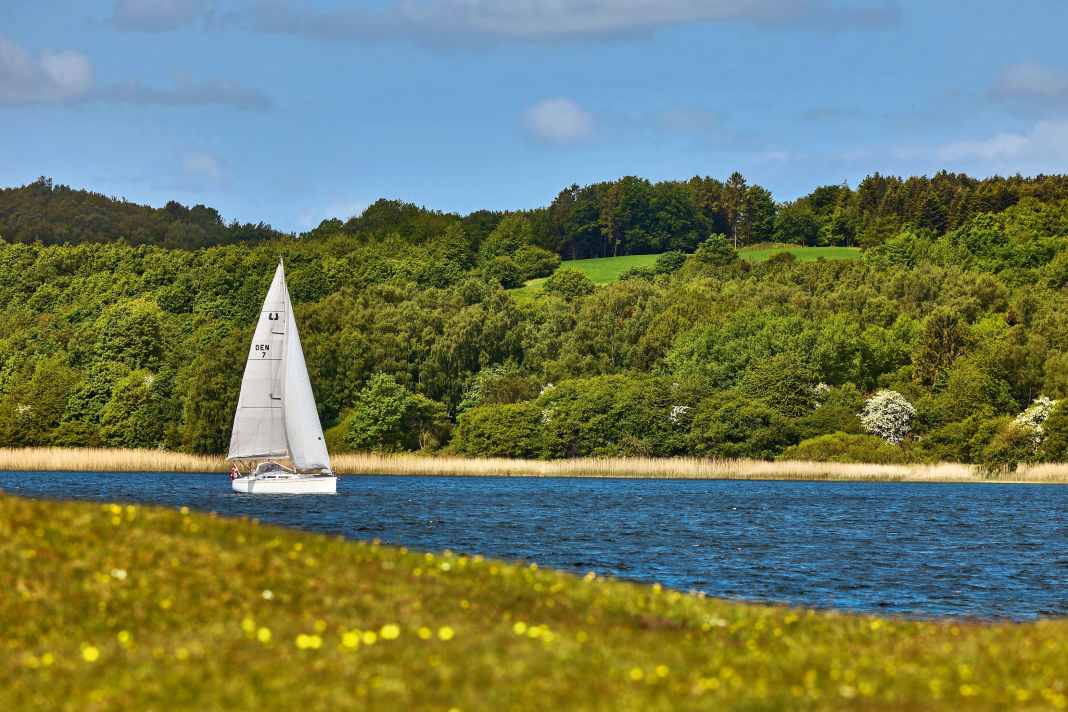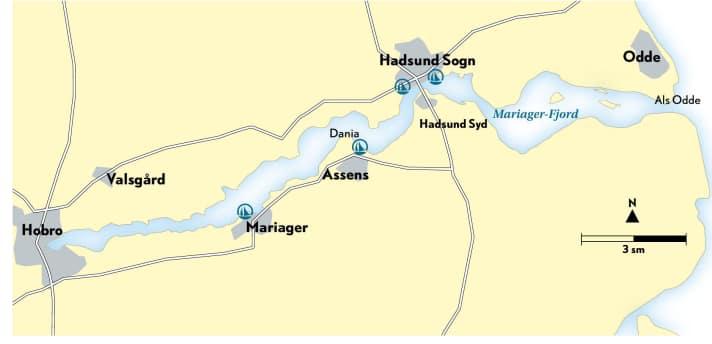





The fjords between Fredericia and Aalborg are not large sailing areas. But they surprise with unexpected diversity. Each one offers pretty harbours, perfect anchor bays and great land attractions - enough for a whole holiday. Let us introduce you:
- Vejle Fjord
- Horsens Fjord
- Mariager Fjord
In the northern part of the Kattegat, the influence of the tide becomes noticeable. The approach to the Mariager Fjord at Als Odde can turn a leisurely trip into a challenging voyage if the weather is right. Especially when there is a strong wind against the tidal current. The situation is exacerbated after a strong easterly wind, as the water masses then flow seawards out of the fjord through the narrow channel.
In moderate conditions and especially at low tide, however, it is pure pleasure to sail through the mudflat-like sandbank landscape, past seal banks and seabird colonies. The 25 metre wide channel is clearly visible during the day. From the Odde westwards, it meanders through the otherwise very shallow fjord.

The Mariager Fjord is a scenic paradise
The much-vaunted beauty of the fjord is yet to come; only after the bascule bridge at Hadsund and after passing the marina do gentle hills and small steep slopes as well as flat banks characterise the area. Almost every type of landscape in Denmark can be found on this section. "We don't leave the area often. We have everything we could wish for here," explains Carl, who is the Commodore of Kongsdal Sejlklub and runs the cosy marina of the same name in the middle of nature. "In addition to our guest berths, we have many anchorages here, suitable for every wind direction. If you want to socialise, there are several small harbours and moorings."
When the striking industrial plants of the former Dania cement works lie across, you can cross at will, as it is usually deep enough to reach the shore. Mariager soon appears, a quintessentially Danish town with cobbled streets and crooked half-timbered houses with roses entwined around them. You imagine yourself on a fantastic journey into a freshly restored past. The smell of waffles and coffee quickly brings the summer holidaymakers back to the present: on the Torvet, the small square with fountain, benches and trees, you can find everything that children's tongues love and also spoils sailors' palates.
Mariager Salt Centre: A museum just for salt
Ole has had his yacht in Mariager's Lystbådehavn harbour for years. "The atmosphere here and the beautiful location of the harbour is unbeatable. We also have a lot of sailors from Germany, who often don't want to leave," laughs the Dane. As in many Danish harbours, the hospitality is palpable; visitors are allowed to use the sanitary facilities as well as parts of the clubhouse with kitchen and utensils.
Close to the harbour, the Mariager Salt Centre is a reminder of Denmark's salty heritage, which was created after the ancient seas dried up. In addition to a salt museum and shop, there is also a spa, café and restaurant.
The fjord extends about five miles further inland and is named after the town of Hobro at the western end. Here, the metamorphosis from an industrial centre to a liveable environment with a chill factor is once again evident. The commercial harbour has been renovated and yachts are moored alongside the southern quay wall.
Mariager Fjord: Tips for shore leave
- Off into the realm of the Vikings to the ring castle of Fyrkat from the year 980, when King Harald Bluetooth ruled. Located three kilometres west of Hobro. ( nordjyskemuseer.dk )
- A trip on the museum railway in Mariager is not just an exciting experience for railway fans. ( mhvj.eu )
- The salt museum and thermal baths in Mariager provide an insight into the bygone days of the salt trade. ( saltcenter.dk )
Further information about the area
The Mariager Fjord should be treated with caution, especially in the entrance area. It can become shallow near the shore and the wind can blow from slightly different directions than predicted in the general forecasts due to the water masses reaching far inland. Depending on the wind, the water levels in the fjords can fluctuate considerably. In the Mariager Fjord (Als Odde), the normal tidal range is 0.3 metres, but when the wind blows from the north it is plus 1.4 metres and from the south minus 1.2 metres. The bascule bridge at Hadsund opens on the hour. And the harbour fee for nine-metre yachts is usually 130 to 180 Danish kroner (equivalent to 18 to 24 euros). Payment is usually made at a machine or online. The towns at the end of the fjord are ideal for a crew change. They are easily accessible by train via Hamburg-Flensburg-Kolding or via the E45 motorway.
Recommended reading for a trip to the fjords
- Jan Werner: "Cruising Guide Denmark 1, Jutland - Anholt - Læsø" (31,99 Euro)
- Peter Hotvedt: "Harbour guide, Denmark and southwest Sweden" (69,90 Euro)
- Set consisting of the Delius Klasing sports boat chart sets 1, 4 and 5: "Danish Baltic Sea + Bay of Kiel" (199,90 Euro)
Fjord or fjord? The origin makes the difference
In Scandinavia, the term fjord refers to an arm of the sea that extends deep inland. From a geological point of view, however, there are differences in how they were formed, and the process of formation also explains the different characteristics of the landscape. According to geological interpretation, fjords were formed by the process of glacial erosion during the ice ages. The ice masses carved deep furrows in the rock massifs, and as they melted they left behind outflows towards the sea. The Norwegian fjords are exemplary for this. In the case of a fjord, a different geological process was at work: as a result of the coastal formation being altered by the advancing ice masses and the rise in sea level after the last ice age, the sea was able to penetrate the flat areas. Storms and tides put the finishing touches to the landscape. This was the case on the Jutland mainland. The landscape and water depth of the fjords were also characterised by factors such as rock type, vegetation and erosion. This also explains the different characters of the fjords of Vejle , Horsens and Mariager.

